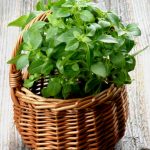You may try to keep basil through the winter, however, sweet basil is meant to live its life cycle within one year and then go to seed. At the end of the season, though, you may try to keep it alive by moving potted basil indoors to enjoy them for months to come.
Inspect And Transplant
Before you bring your basil indoors make sure to inspect it thoroughly for any insects. Flush the soil with water and rinse off the foliage, using a blast of water from the garden hose to chase away any pests and avoid later problems. Then, you can gently dig up your basil from the garden any time before the ground freezes.
Transfer To A Pot
Select a container large enough to accommodate your basil plus a little room for growth. Place a layer of potting mix on the bottom of the pot, then set the basil on top of that. Fill in the spaces around the roots with more potting mix. Press the soil firmly around the basil’s roots, leaving about an inch between the soil and the rim of the pot. For smaller basil plants, try placing several together in a window box that fits on a sunny sill. After settling your basil into its new container, water until it drains out the bottom of the pot.
Acclimate Your Basil
When bringing your basil indoors, it will need a little time to adjust to the new surroundings. You might notice that your basil drops a few leaves and grow more slowly. Ease your basil into life on the inside by setting them in a spot with indirect light. Don’t put them in bright sun right away. After a couple of weeks, you may move the pots to a spot that will get a least four hours of sun or bright light. If you don’t have a window that provides plenty of sunlight, you can also grow your herbs under fluorescent bulbs or with a grow light setup.
Give Your Basil Some Love
Turn pots once a week or so to help all sides of your basil get enough light. Water when the soil feels dry to a depth of 1 inch. Mist the leaves daily to boost the humidity level. You can also tilt the pots over the sink and gently rinse their foliage with tap water every once in a while, to keep them clean and deter any pests that might show up. You may want to boost the humidity around your basil by placing their pots in a pebble filled tray. Water the pot regularly, allowing excess water to over flow into the tray.
Cuttings
To make sure you always have access to fresh basil throughout the winter, places cuttings in a small vase of water and they will soon develop roots. When the roots are a couple of inches long, put the cuttings to expand you supply of fresh basil. Or you may snip sprigs whenever you need some fresh basil for your favorite dishes. Either way, this will encourage your basil to produce new growth and stay compact until you can move them outdoors again in the spring.
With a little preparation, basil can come indoors for the winter. Growing them in containers will give you a fresh supply for cooking all year long and you will be able to take them back outside and replant when spring arrives.
©Tiny New York Kitchen © 2020 All Rights Reserved
Welcome Spring. We rejoice in longer days and the vision of growth and rebirth after a long winter. The seeds planted last autumn have germinated over the winter, have become buds, and are beginning to break through the cold earth. These are signs of renewal and hope that start to stir within each of us. The seeds of change that we planted within ourselves now push through with the new energy we feel. A sense of renewal gives us the vision and inspiration to bring our creative energy to fruition.
“Work With What You Got!”
©Tiny New York Kitchen © 2018 All Rights Reserved
Have you ever come home from the market after purchasing fruit to find that you spent money for nothing? I have plenty of times and it ticks me off every time. Here are some Fruit Essentials that may help you have more fruit shopping success.
Did you know that many plants that are botanically fruits are not sweet? We think of them as vegetables or non-fruits. Avocados, beans, coconuts, corn, cucumbers, eggplants, green peppers, okra, peas, pumpkins, sugar peas, string beans and tomatoes all fall in the fruit category. Some cookbooks make a distinction between fruit, vegetables and fruit vegetables. Fruit vegetables are foods that are botanically fruits, but are most often prepared and served like vegetables. These fruits are considered fruit vegetables: Aubergine, autumn squash, avocado, bitter melon, cantaloupe, chayote, chile, courgette, cucumber, eggplant, gherkin, green bean, green sweet pepper, hot pepper, marrow, muskmelon, okra, olive, pumpkin, red sweet pepper, seedless cucumber, squash, sweet pepper, tomatillo, tomato, watermelon, wax gourd, yellow sweet pepper and zucchini.
Pectin is a substance contained in some fruit which is used for making jams and jellies thicker. High pectin fruits are apples, cranberries, currants, lemons, oranges, plums and quinces. Low pectin fruits are bananas, cherries, grapes, mangos, peaches, pineapples and strawberries.
Low pectin fruits seem to discolor quicker than high pectin fruits ( bananas and eggplants). Lemon juice or vinegar slows the discoloring process. Other fruits and vegetables that discolor quickly are avocados, cauliflower, celery, cherries, figs, Jerusalem artichokes, mushrooms, nectarines, parsnips, peaches, pears, potatoes, rutabaga and yams.
Bruising: When a fruit is bruised the cell walls break down and discoloration begins. The process can be slowed down by refrigeration.
Cleaning: It is important to clean our fruit and vegetables. Rinse fruit in cold running water and scrub as needed before cooking or eating. Soaking fruit in water for more than a few minutes can leach out water soluble vitamins.
Peeling: The fruit skin usually contains a lot of important nutrients, but if you need to peel a thick-skinned fruit cut a small amount of the peel from the top and bottom. Then on a cutting board cut off the peel in strips from top to bottom. A good way to peel thin skinned fruit is to place the fruit in a bowl with boiling water and let stand for about 1 minute. Remove and cool in an ice water bath. You could also spear the fruit with a fork and hold over a gas flame until the skin cracks OR quarter the fruit and peel with a sharp paring knife or potato peeler.
Wax: Oh those beautiful waxed apples that wink at us at the market. They are beautiful because they are waxed. I don’t know about you, but I would rather not eat wax. Wax can be removed from the surface of fruits by washing them with a mild dishwashing soap and then thoroughly rinsing them. This will remove most of the wax, but probably not all of it.
Purchasing Ripe: Purchase these fruits fully ripe: Berries, cherries, citrus, grapes and watermelon. All of the fruits in this list, except berries, can be refrigerated without losing flavor.
Purchasing Not-So-Ripe: Apricots, figs, melons, nectarines, peaches and plums develop more complex flavors after picking. Store these fruits at room temperature until they are as ripe as you would like them.
Refrigeration: You can refrigerate apples,ripe mangos and ripe pears as soon as you get them. Do not refrigerat bananas.
Seasonal Fruit: Winter is the season for citrus. Fall is the season for apples and pears. Late spring is the season for strawberries and pineapples. Summer is perfect for blueberries, melons, peaches and plums.
Washing: Dry fruit with paper towels or kitchen towels and then use a blow dryer on the cool setting to completely dry fruit.
Squeezing: A microwave can be used to get more juice from citrus fruits. Microwave citrus fruits for about 20 seconds before squeezing the fruit for juice.









